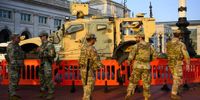In a dramatic escalation of federal response to unrest in the nation’s capital, the Trump administration announced on August 16, 2025, that National Guard troops deployed to Washington, D.C., may now be armed, a marked departure from assurances made just days prior. The move, confirmed by multiple officials and reported by CBS News and The Wall Street Journal, comes as President Donald Trump seeks to assert control over what he has described as a city beset by violent crime and disorder.
Earlier in the week, defense officials and the Army had maintained that the National Guard troops—numbering around 800 at the time—would not be armed, and that weapons would remain secured in armories. On August 14, the U.S. Army had issued a press release stating, “Weapons are available if needed but will remain in the armory.” This policy was echoed by officials who said not only would troops not carry weapons, but they also would not have them in their vehicles.
But by Saturday, August 16, the administration had reversed course. According to a White House official, “The National Guard is not making arrests at this time—they may be armed, consistent with their mission and training, to protect federal assets, provide a safe environment for law enforcement officers to make arrests, and deter violent crime with a visible law enforcement presence,” as reported by CBS News. A National Guard spokesman confirmed to the network that troops “may be armed consistent with their mission and training,” emphasizing that their presence was focused on supporting civil authorities and ensuring community safety.
The shift in policy was not entirely unexpected for some. According to The Wall Street Journal, certain National Guard troops were informed as early as Friday, August 15, to anticipate orders that would require them to carry weapons. This new directive comes amid growing concern within the administration about the ability to maintain order in the city, and it reflects a broader strategy to project strength and deter further violence.
President Trump first announced the deployment of the National Guard to Washington, D.C., on August 11, 2025, stating his intention to “rescue our nation’s capital from crime, bloodshed, bedlam and squalor and worse.” He also revealed plans to place the city’s Metropolitan Police Department under federal control—an extraordinary measure permitted by the District of Columbia Home Rule Act, which allows the president to take over the police department during emergencies for up to 48 hours at a time.
The administration’s efforts to replace the district’s police chief, however, met resistance. Following the urging of a federal judge, the Justice Department reversed its course on this aspect of the intervention, leaving the local leadership in place for the time being.
Trump’s decision to escalate federal involvement in Washington, D.C., came in the wake of a high-profile assault earlier in August. Edward Coristine, a staffer at the Social Security Administration and a former Department of Government Efficiency employee known as “Big Balls,” was attacked by a group of teenagers. The president described the incident in stark terms, saying Coristine “was left dripping in blood. He thought he was dead with a broken nose and concussion.” This episode, cited by Trump as emblematic of the city’s lawlessness, appears to have galvanized the administration’s resolve to act decisively.
The deployment of armed National Guard troops to the capital is not without precedent. In 2020, during Trump’s first term, some 62,000 National Guard Soldiers and Airmen were activated across 23 states and Washington, D.C., in response to nationwide protests following the police killing of George Floyd. More recently, in June 2025, Trump ordered the National Guard to Los Angeles to quell unrest related to Immigration and Customs Enforcement (ICE) raids and courthouse arrests. These actions have drawn both praise and criticism, reflecting the deep divisions in American politics over the use of military force in domestic affairs.
On August 16, the Trump administration received a boost from several Republican governors who pledged to send additional National Guard troops to support the federal initiative in Washington. West Virginia Governor Patrick Morrisey announced that his state would deploy hundreds of troops to the capital, stating in a press release, “West Virginia is proud to stand with President Trump in his effort to restore pride and beauty to our nation’s capital. The men and women of our National Guard represent the best of our state, and this mission reflects our shared commitment to a strong and secure America.” South Carolina Governor Henry McMaster committed 200 troops, while Ohio Governor Mike DeWine pledged 150 more, further bolstering the federal presence in the city.
Despite the administration’s insistence that the National Guard is not engaging in arrests, the line between military support and direct law enforcement remains blurry. The Posse Comitatus Act broadly forbids the use of the military as a domestic police force, but National Guard troops—when under state authority or federalized for certain missions—can play supporting roles. According to the Army, while they are not permitted to make arrests, “they are allowed to temporarily detain individuals to prevent imminent harm.”
President Trump has signaled that Washington, D.C., may not be the last city to see such a deployment. “We have other cities also that are bad,” he declared on August 11. “We’re not going to let it happen. We’re not going to lose our cities over this. And this will go further. We’re starting very strongly with D.C., and we’re going to clean it up real quick, very quickly.” This rhetoric has sparked speculation—and concern—about the potential for similar interventions elsewhere in the country as the administration confronts what it views as a wave of urban disorder.
For supporters, the administration’s approach is a necessary step to restore order and protect citizens in the face of rising crime. They argue that a strong federal response is warranted when local authorities are unable or unwilling to maintain public safety. As Governor Morrisey put it, the mission is about “a strong and secure America.”
Critics, however, worry about the implications for civil liberties and the precedent set by deploying armed troops on American streets. They point to the dangers of blurring the lines between military and civilian policing and warn that such measures could inflame tensions rather than resolve them. The administration’s shifting stance on arming the National Guard—moving from unarmed support to a visibly armed presence—has only heightened these concerns.
As more troops arrive in the capital and prepare to carry weapons, the eyes of the nation are fixed on Washington, D.C. The coming days will test not only the administration’s resolve but also the city’s resilience and the delicate balance between security and liberty.
With the stakes high and the nation’s capital at the center of political and social tumult, the deployment of armed National Guard troops marks a pivotal moment in the ongoing debate over how best to keep America’s cities safe.




